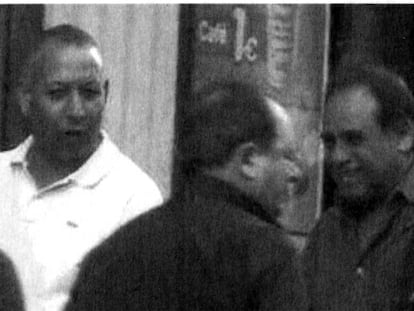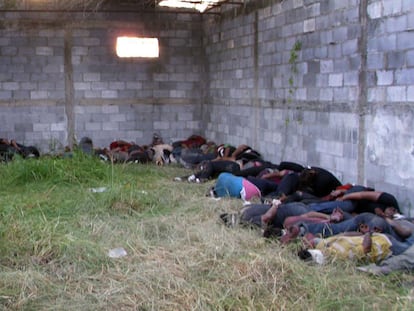The spider web of federal funds that go to fighting the drug war in Mexico
In addition to the Mexican government’s growing budget, the US continues to provide assistance
The United States government inadvertently made thousands of assault rifles available to Mexican drug cartels along the US-Mexican border in 2009 during the failed Operation dubbed “Fast and Furious.” The mission attempted to locate cartel bosses and dealers by tracing shipments of illegal arms, but American officials lost track of the weapons and the strategy failed. Neither the US nor Mexico knew the destination of those arms or managed to locate any drug bosses.

Over the following years, various crime scenes throughout Mexico revealed some of the pieces of that bloody puzzle. In the last decade, both countries have financed operations to combat drug trafficking on the Mexican side. Despite their lack of success, the US and Mexico keep adding zeros to the budget for the war against drugs.
Over the last 10 years, Mexico has spent more than 1.5 billion pesos ($71.4 million) to combat its public enemy number one. The Mexican federal budget for the drug war grows by approximately 15% every year. With no intention of retreat, presidents Felipe Calderón and Enrique Peña Nieto both expanded the navy and army, the main weapons used in the fight against drugs. They restructured police forces, including the new gendarmerie, and expanded intelligence operations. The Mexican federal government also invested in the judicial sector, which has been calling for a transformation since 2008 though no changes have been made yet.
For the first time American lawmakers are questioning the effectiveness of this expensive war on drugs
In 2008, the US joined Mexico’s frontal assault against the drug trade. The American government allocated $2.5 million through the Mérida Initiative to help Mexico annihilate the cartels. George W. Bush and Felipe Calderón signed the pact that also promised to reinforce security at the border. That partnership allowed, among other things, the sharing of intelligence that led to the capture of Joaquín “El Chapo” Guzmán in February 2014. American officials provided military helicopters and training for the Mexican armed forces until 2014, when the United States began to question Mexico’s commitment to human rights after the disappearance of 43 student teachers in Ayotzinapa.
For the first time American lawmakers are questioning the effectiveness of this expensive war on drugs. Democratic Senator Patrick J. Leahy has urged his colleagues to block next year’s allocations given that Mexico “has allowed its own police and military officers to avoid punishment for committing and covering up heinous crimes.” The Mérida Initiative sought to reproduce the results of the 1990s “Plan Colombia” by reducing drug activity. Critical voices such as Leahy’s, however, have grown faint because it seems as if the US will keep financing anti-drug efforts in Mexico. “The United States is satisfied with the minimum because they are complying with a political formula of financial assistance that also ensures that its point of view and its way of doing things prevail,” says Ernesto López Portillo, director of the Institute for Security and Democracy in Mexico (Insyde).
The strategy for 2017 is the same as always: increase resources with a focus on the judicial system and on training for law enforcement
“We are not satisfied with what we have achieved,” Mexican President Enrique Peña Nieto admitted a week ago, during the 41st council on national and public security. His frankness comes just as public perception of security is shifting: 71.9% of Mexicans say they feel unsafe in their country. Yet the strategy for 2017 is the same as always: increase resources with a focus on the judicial system and on training for law enforcement. “Indicators are not improving because public policies are not improving. You can repeat the same policies even though there are no results because there are no consequences,” says López Portillo.
Mexican officials operate within a framework where funds allocated for security tunnel down a spiral that produces poor results, Insyde’s director adds. And the federal government ignored community-based opportunities to improve security throughout the last decade. The Peña Nieto administration cut the budget for crime prevention this year while it continued to provide resources to a network that sows exactly what it attempts to destroy. “The Mexican state invests to lose,” López Portillo says. It remains to be seen whether American President-elect Donald Trump will continue to support this old Mexican strategy in 2017.
English version by Dyane Jean François.
Tu suscripción se está usando en otro dispositivo
¿Quieres añadir otro usuario a tu suscripción?
Si continúas leyendo en este dispositivo, no se podrá leer en el otro.
FlechaTu suscripción se está usando en otro dispositivo y solo puedes acceder a EL PAÍS desde un dispositivo a la vez.
Si quieres compartir tu cuenta, cambia tu suscripción a la modalidad Premium, así podrás añadir otro usuario. Cada uno accederá con su propia cuenta de email, lo que os permitirá personalizar vuestra experiencia en EL PAÍS.
¿Tienes una suscripción de empresa? Accede aquí para contratar más cuentas.
En el caso de no saber quién está usando tu cuenta, te recomendamos cambiar tu contraseña aquí.
Si decides continuar compartiendo tu cuenta, este mensaje se mostrará en tu dispositivo y en el de la otra persona que está usando tu cuenta de forma indefinida, afectando a tu experiencia de lectura. Puedes consultar aquí los términos y condiciones de la suscripción digital.
More information
Archived In
Últimas noticias
The complicated life of Francesca Albanese: A rising figure in Italy but barred from every bank by Trump’s sanctions
How Japan is trying to avert ‘digital defeat’
Reinhard Genzel, Nobel laureate in physics: ‘One-minute videos will never give you the truth’
Pinochet’s victims grapple with José Antonio Kast’s rise in Chile
Most viewed
- Pablo Escobar’s hippos: A serious environmental problem, 40 years on
- Why we lost the habit of sleeping in two segments and how that changed our sense of time
- Trump’s obsession with putting his name on everything is unprecedented in the United States
- The Florida Keys tourist paradise is besieged by immigration agents: ‘We’ve never seen anything like this’
- Charles Dubouloz, mountaineering star, retires at 36 with a farewell tour inspired by Walter Bonatti











































